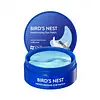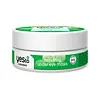What's inside
What's inside
 Key Ingredients
Key Ingredients

 Benefits
Benefits

 Concerns
Concerns

 Ingredients Side-by-side
Ingredients Side-by-side

Water
Skin ConditioningGlycerin
HumectantCalcium Chloride
AstringentCeratonia Siliqua Gum
EmollientXanthan Gum
EmulsifyingSwiftlet Nest Extract
Skin ConditioningButylene Glycol
Humectant1,2-Hexanediol
Skin ConditioningPentylene Glycol
Skin ConditioningHydroxyacetophenone
AntioxidantChondrus Crispus Powder
AbrasiveScutellaria Baicalensis Root Extract
AstringentCamellia Sinensis Leaf Extract
AntimicrobialHouttuynia Cordata Extract
Skin ConditioningArtemisia Princeps Leaf Extract
Skin ConditioningCitrus Junos Fruit Extract
Skin ConditioningCaprylyl Glycol
EmollientAllantoin
Skin ConditioningPEG-60 Hydrogenated Castor Oil
EmulsifyingBetaine
HumectantPanthenol
Skin ConditioningEthylhexylglycerin
Skin ConditioningCalcium Titanium Borosilicate
AbrasiveMica
Cosmetic ColorantCI 77510
Cosmetic ColorantTin Oxide
AbrasiveCI 77891
Cosmetic ColorantRosa Centifolia Flower Water
Skin ConditioningChamaecyparis Obtusa Water
MaskingSodium Hyaluronate
HumectantAloe Barbadensis Leaf Extract
EmollientCucumis Sativus Fruit Extract
EmollientHydroxyethylcellulose
Emulsion StabilisingDisodium EDTA
Dipotassium Glycyrrhizate
HumectantParfum
MaskingSapphire Powder
Water, Glycerin, Calcium Chloride, Ceratonia Siliqua Gum, Xanthan Gum, Swiftlet Nest Extract, Butylene Glycol, 1,2-Hexanediol, Pentylene Glycol, Hydroxyacetophenone, Chondrus Crispus Powder, Scutellaria Baicalensis Root Extract, Camellia Sinensis Leaf Extract, Houttuynia Cordata Extract, Artemisia Princeps Leaf Extract, Citrus Junos Fruit Extract, Caprylyl Glycol, Allantoin, PEG-60 Hydrogenated Castor Oil, Betaine, Panthenol, Ethylhexylglycerin, Calcium Titanium Borosilicate, Mica, CI 77510, Tin Oxide, CI 77891, Rosa Centifolia Flower Water, Chamaecyparis Obtusa Water, Sodium Hyaluronate, Aloe Barbadensis Leaf Extract, Cucumis Sativus Fruit Extract, Hydroxyethylcellulose, Disodium EDTA, Dipotassium Glycyrrhizate, Parfum, Sapphire Powder
Water
Skin ConditioningAloe Barbadensis Leaf Juice
Skin ConditioningGlycerin
HumectantPentylene Glycol
Skin ConditioningPropanediol
SolventCucumis Sativus Fruit Water
Skin ConditioningCucumis Sativus Seed Extract
Skin ConditioningCamellia Sinensis Leaf Extract
AntimicrobialBrassica Oleracea Italica Extract
AstringentChamomilla Recutita Flower Extract
MaskingPeucedanum Graveolens Extract
TonicSpinacia Oleracea Leaf Extract
Skin ConditioningPunica Granatum Bark/Fruit Extract
AntimicrobialLactobacillus Ferment
Skin ConditioningLactobacillus Ferment Lysate
Skin ConditioningCaffeine
Skin ConditioningDipotassium Glycyrrhizate
Humectant1,2-Hexanediol
Skin ConditioningXanthan Gum
EmulsifyingTetrasodium Glutamate Diacetate
Citric Acid
BufferingCaprylhydroxamic Acid
Parfum
MaskingWater, Aloe Barbadensis Leaf Juice, Glycerin, Pentylene Glycol, Propanediol, Cucumis Sativus Fruit Water, Cucumis Sativus Seed Extract, Camellia Sinensis Leaf Extract, Brassica Oleracea Italica Extract, Chamomilla Recutita Flower Extract, Peucedanum Graveolens Extract, Spinacia Oleracea Leaf Extract, Punica Granatum Bark/Fruit Extract, Lactobacillus Ferment, Lactobacillus Ferment Lysate, Caffeine, Dipotassium Glycyrrhizate, 1,2-Hexanediol, Xanthan Gum, Tetrasodium Glutamate Diacetate, Citric Acid, Caprylhydroxamic Acid, Parfum
Ingredients Explained
These ingredients are found in both products.
Ingredients higher up in an ingredient list are typically present in a larger amount.
1,2-Hexanediol is a synthetic liquid and another multi-functional powerhouse.
It is a:
- Humectant, drawing moisture into the skin
- Emollient, helping to soften skin
- Solvent, dispersing and stabilizing formulas
- Preservative booster, enhancing the antimicrobial activity of other preservatives
Camellia Sinensis Leaf Extract is derived from the leaves of the tea plant. Black tea, green tea, and oolong tea are all harvested from this plant.
This ingredient has many skin benefits:
This ingredient contains polyphenols, a strong antioxidant. Antioxidants help fight off molecules that damage skin cells.
On top of that, the antioxidants in green tea neutralize free-radicals from the sun. This gives the skin some extra UV protection, but should not replace sunscreen.
Many components of tea have anti-inflammatory properties.
Polyphenols and L-theanine help soothe the skin and reduce irritation. The caffeine in Camellia Sinensis Leaf Extract helps calm inflamed blood vessels.
Other compounds found in tea include: Vitamin Bs, linoleic acid, magnesium, calcium, iron, and zinc.
Research has shown both drinking Camellia Sinensis Leaf Tea and applying it to the skin can help boost skin elasticity and hydration. Studies also show using tea extract may reduce sebum, or oil, production.
Learn more about Camellia Sinensis Leaf ExtractDipotassium Glycyrrhizate comes from licorice root.
Extracts of licorice have demonstrated to have antibacterial, anti‐inflammatory, antiviral, antioxidant properties.
One component, glabridin, has extra potent antioxidant and soothing properties. It has also been found to block pigmentation from UVB rays in guinea pigs.
Licorice Root also contains a flavonoid. Flavonoids are a natural substance from in plants. Flavonoids also have antioxidant properties.
Another component, glycyrrhizin, has been found to have anti-inflammatory and antimicrobial benefits. This may make licorice root extract effective at treating acne. However, more research is needed to support this.
Liquiritin is one of the flavone compounds found in licorice. It has been found to help lighten skin by preventing tyrosinase from reacting with tyrosine. When the two react, protein is converted to melanin. Melanin is the substance in your body that gives your features pigmentation.
Licorice root is native to Southern Europe and Asia. It has been used in traditional Chinese medicine to help with respiratory issues.
Learn more about Dipotassium GlycyrrhizateGlycerin is already naturally found in your skin. It helps moisturize and protect your skin.
A study from 2016 found glycerin to be more effective as a humectant than AHAs and hyaluronic acid.
As a humectant, it helps the skin stay hydrated by pulling moisture to your skin. The low molecular weight of glycerin allows it to pull moisture into the deeper layers of your skin.
Hydrated skin improves your skin barrier; Your skin barrier helps protect against irritants and bacteria.
Glycerin has also been found to have antimicrobial and antiviral properties. Due to these properties, glycerin is often used in wound and burn treatments.
In cosmetics, glycerin is usually derived from plants such as soybean or palm. However, it can also be sourced from animals, such as tallow or animal fat.
This ingredient is organic, colorless, odorless, and non-toxic.
Glycerin is the name for this ingredient in American English. British English uses Glycerol/Glycerine.
Learn more about GlycerinParfum is a catch-all term for an ingredient or more that is used to give a scent to products.
Also called "fragrance", this ingredient can be a blend of hundreds of chemicals or plant oils. This means every product with "fragrance" or "parfum" in the ingredients list is a different mixture.
For instance, Habanolide is a proprietary trade name for a specific aroma chemical. When used as a fragrance ingredient in cosmetics, most aroma chemicals fall under the broad labeling category of “FRAGRANCE” or “PARFUM” according to EU and US regulations.
The term 'parfum' or 'fragrance' is not regulated in many countries. In many cases, it is up to the brand to define this term.
For instance, many brands choose to label themselves as "fragrance-free" because they are not using synthetic fragrances. However, their products may still contain ingredients such as essential oils that are considered a fragrance by INCI standards.
One example is Calendula flower extract. Calendula is an essential oil that still imparts a scent or 'fragrance'.
Depending on the blend, the ingredients in the mixture can cause allergies and sensitivities on the skin. Some ingredients that are known EU allergens include linalool and citronellol.
Parfum can also be used to mask or cover an unpleasant scent.
The bottom line is: not all fragrances/parfum/ingredients are created equally. If you are worried about fragrances, we recommend taking a closer look at an ingredient. And of course, we always recommend speaking with a professional.
Learn more about ParfumPentylene glycol is typically used within a product to thicken it. It also adds a smooth, soft, and moisturizing feel to the product. It is naturally found in plants such as sugar beets.
The hydrophilic trait of Pentylene Glycol makes it a humectant. As a humectant, Pentylene Glycol helps draw moisture from the air to your skin. This can help keep your skin hydrated.
This property also makes Pentylene Glycol a great texture enhancer. It can also help thicken or stabilize a product.
Pentylene Glycol also acts as a mild preservative and helps to keep a product microbe-free.
Some people may experience mild eye and skin irritation from Pentylene Glycol. We always recommend speaking with a professional about using this ingredient in your routine.
Pentylene Glycol has a low molecular weight and is part of the 1,2-glycol family.
Learn more about Pentylene GlycolWater. It's the most common cosmetic ingredient of all. You'll usually see it at the top of ingredient lists, meaning that it makes up the largest part of the product.
So why is it so popular? Water most often acts as a solvent - this means that it helps dissolve other ingredients into the formulation.
You'll also recognize water as that liquid we all need to stay alive. If you see this, drink a glass of water. Stay hydrated!
Learn more about WaterXanthan gum is used as a stabilizer and thickener within cosmetic products. It helps give products a sticky, thick feeling - preventing them from being too runny.
On the technical side of things, xanthan gum is a polysaccharide - a combination consisting of multiple sugar molecules bonded together.
Xanthan gum is a pretty common and great ingredient. It is a natural, non-toxic, non-irritating ingredient that is also commonly used in food products.
Learn more about Xanthan Gum